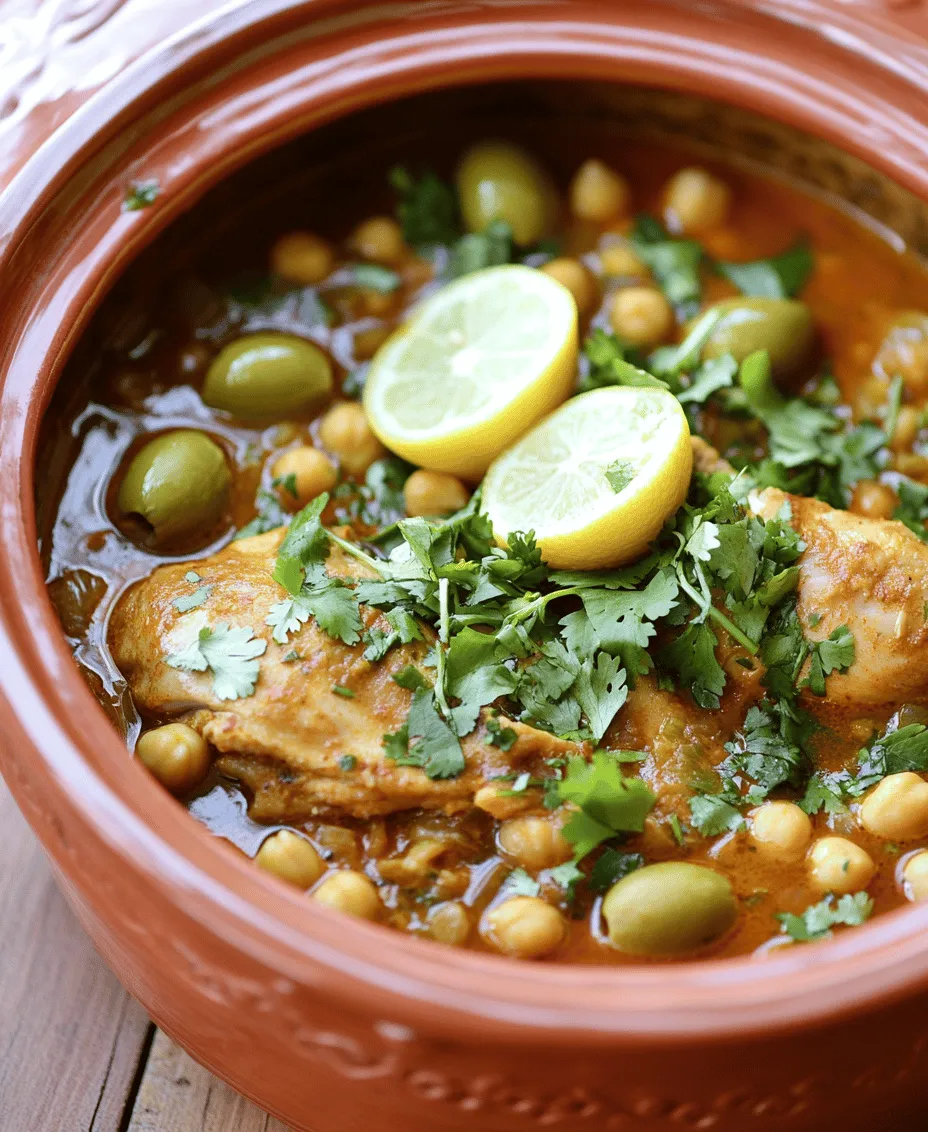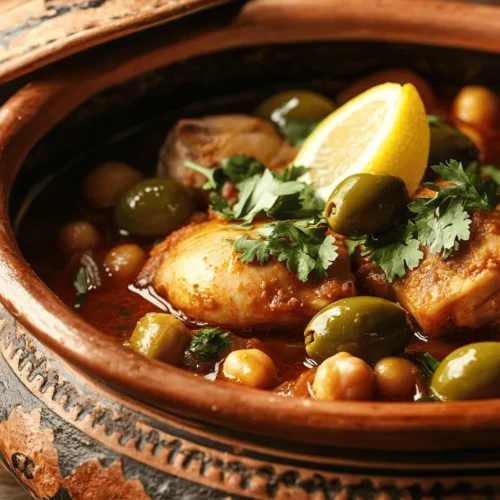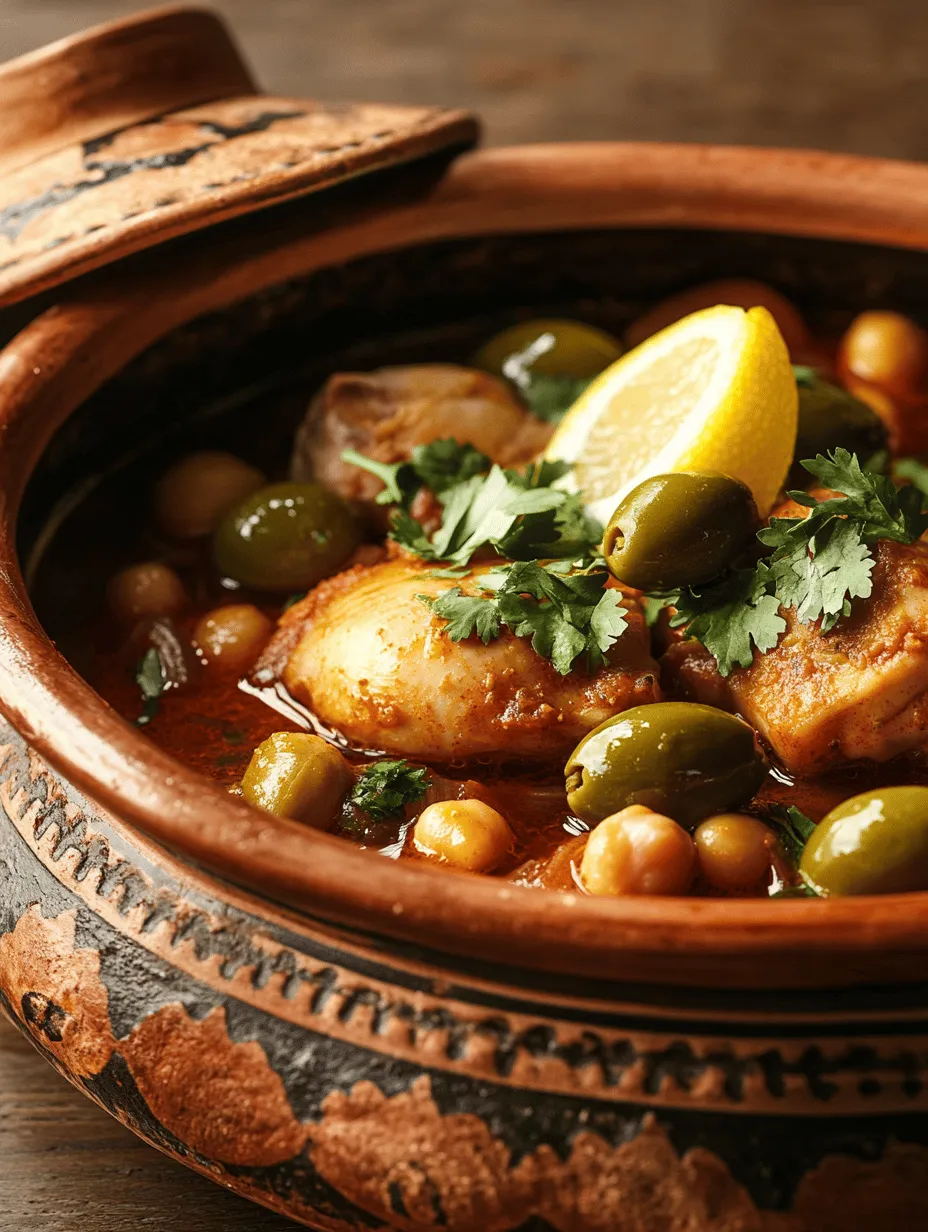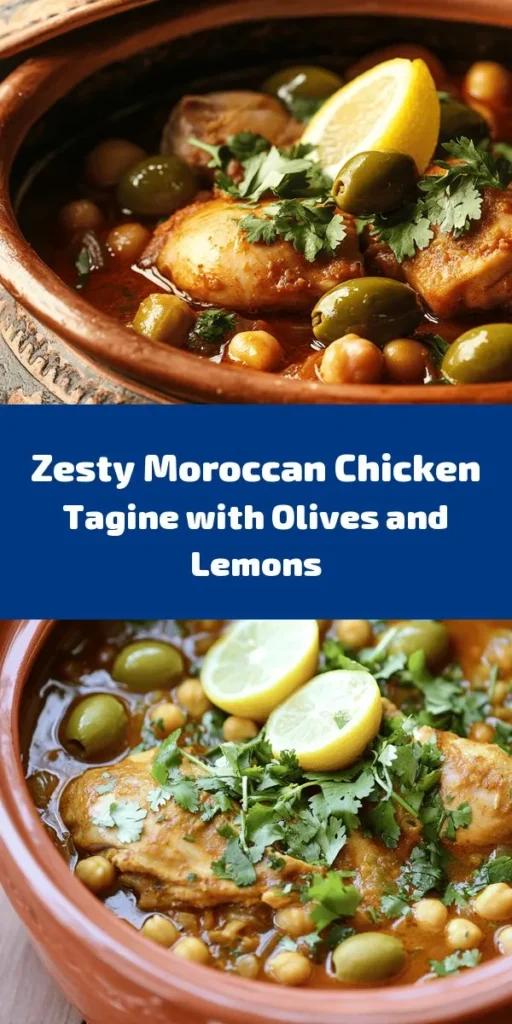Introduction to Moroccan Chicken Tagine
Dive into the heart of Moroccan cuisine with this rich and flavorful Chicken Tagine recipe. Known for its vibrant flavors and aromatic spices, Moroccan cooking is a celebration of texture and taste, and nothing embodies this better than a traditional tagine. This particular dish features succulent chicken thighs cooked with green olives and zesty lemons, resulting in a mouthwatering experience that is both comforting and exotic. Whether you are preparing a family dinner or looking to impress guests at a special occasion, this Moroccan Chicken Tagine is sure to be a hit.
The term “tagine” refers not only to the dish itself but also to the traditional earthenware pot in which it is cooked. The unique conical shape of a tagine allows for slow cooking, helping to lock in moisture and infuse the chicken with the aromatic spices and flavors of the other ingredients. With each bite, you’ll be transported to the bustling markets and vibrant streets of Morocco, where the air is filled with the scents of spices and freshly prepared meals.
Understanding the Ingredients
Chicken Thighs: The Heart of the Dish
At the core of any great Chicken Tagine is the chicken itself, and for this recipe, we recommend using skin-on, bone-in chicken thighs. While some may opt for chicken breasts due to their leanness, thighs bring a depth of flavor and tenderness that is unmatched. The bone helps to keep the meat moist during the cooking process, while the skin adds a layer of richness that enhances the overall experience of the dish.
Choosing chicken thighs also means you’ll benefit from a more robust flavor profile. Unlike white meat, which can dry out quickly, dark meat retains its juiciness and can hold up beautifully against the bold spices and other ingredients used in this recipe. This is particularly important in a dish like tagine, where the chicken is simmered for an extended period, allowing the flavors to meld and deepen.
The Role of Spices
Spices are the lifeblood of Moroccan cuisine, and this Chicken Tagine recipe employs a careful selection of spices that create its distinct flavor profile. Here’s an overview of the key spices used:
– Cumin: Known for its warm, earthy flavor, cumin adds depth to the dish and pairs beautifully with chicken. It is a staple in Moroccan cooking.
– Coriander: This spice offers a slightly citrusy note, enhancing the overall brightness of the dish. Ground coriander complements the chicken and balances the richness of the olives.
– Ginger: Fresh ginger adds a zesty kick, which brings a touch of heat and a refreshing flavor that cuts through the richness of the other ingredients.
– Paprika: Sweet paprika adds a subtle smokiness and vibrant color to the tagine, making it visually appealing as well as flavorful.
– Cinnamon: A pinch of cinnamon provides warmth and sweetness, giving the dish a unique depth that is characteristic of Moroccan flavors.
Together, these spices create a harmonious blend that elevates the chicken and other ingredients, making every bite a delightful experience.
Fresh Ingredients for Authenticity
To truly capture the essence of Moroccan Chicken Tagine, the use of fresh ingredients is essential. Here’s a closer look at some of the key components:
– Garlic and Onion: Fresh garlic and onion are foundational in building the flavor base of the tagine. They should be sautéed until golden brown to release their natural sweetness and aromatic qualities.
– Lemons: The use of both lemon zest and juice is crucial for adding brightness to the dish. The acidity of the lemons helps to balance the rich flavors of the chicken and olives, making each bite refreshing.
– Olives: Green olives lend a briny, savory quality that complements the sweetness of the chicken and the tartness of the lemons. Their unique texture adds another layer of complexity to the dish.
– Chickpeas: While not always included, chickpeas can add a wonderful texture and heartiness to the tagine. They absorb the flavors of the spices and broth, enriching the overall dish.
Preparing for Cooking
Essential Tools and Equipment
When preparing Moroccan Chicken Tagine, having the right tools can make all the difference. Here are some essential items you should have on hand:
– Tagine Pot or Heavy-Bottomed Pot: If you have a traditional tagine pot, it’s perfect for this recipe. However, if you don’t, a heavy-bottomed pot or Dutch oven will work just as well. These pots retain heat evenly and help to prevent burning while allowing for slow cooking.
– Good Knife: A sharp knife is crucial for efficiently chopping onions and mincing garlic. A well-balanced knife will make your prep work easier and safer, allowing you to focus on the cooking process.
– Cutting Board: Use a sturdy cutting board to chop your ingredients. A non-slip surface will help keep everything steady while you work.
Prepping Your Ingredients
Preparation is key to a successful tagine. Here are some tips to help you get started:
– Chopping Onions and Mincing Garlic: For the onions, slice them in half from root to tip, then make vertical and horizontal cuts before dicing. This method allows for even pieces that cook uniformly. For garlic, use the flat side of your knife to crush the cloves slightly, making them easier to peel. Then, mince finely to release their flavor.
– Preparing Lemons: To zest and juice lemons, start by washing them thoroughly. Use a microplane or zester to remove the yellow outer layer without hitting the bitter white pith. For juicing, cut the lemons in half and use a citrus juicer or your hands to extract as much juice as possible.
Cooking the Moroccan Chicken Tagine
Step-by-Step Cooking Instructions
Now that you have all your ingredients prepped, it’s time to start cooking. Follow these detailed instructions for a successful Moroccan Chicken Tagine:
1. Browning the Chicken: Begin by heating a few tablespoons of olive oil in your tagine or heavy-bottomed pot over medium-high heat. Once the oil is hot, add the chicken thighs skin-side down. Browning the chicken is an essential step, as it caramelizes the skin and enhances the flavor. Allow the chicken to cook for about 5-7 minutes on each side until golden brown. Avoid overcrowding the pot, as this can cause the chicken to steam rather than brown. Work in batches if necessary.
2. Sautéing Onions and Garlic: Once the chicken is browned, remove it from the pot and set it aside. In the same pot, add the chopped onions and sauté them for about 5 minutes until they become translucent and start to caramelize. Add the minced garlic and cook for an additional minute, stirring frequently to prevent burning. The goal is to develop a rich, sweet base for the tagine.
3. Toasting Spices: After the onions and garlic are ready, it’s time to add the spices. Sprinkle in the cumin, coriander, ginger, paprika, and cinnamon, and toast them for about 1-2 minutes. This process awakens the essential oils in the spices, intensifying their flavors and making your kitchen smell incredible.
4. Deglazing the Pot: With the spices fragrant, it’s time to deglaze the pot. Pour in a cup of chicken broth and the juice from the zested lemons, scraping the bottom of the pot with a wooden spoon to lift any browned bits. This step is crucial as it incorporates all the delicious flavors into the sauce.
5. Combining Ingredients for Optimal Flavor: Return the browned chicken to the pot, skin-side up. Add the olives and any additional ingredients like chickpeas if desired. Ensure the chicken is nestled into the broth without being submerged completely; this allows the skin to crisp up while the meat cooks through. Sprinkle the lemon zest on top for an extra burst of flavor.
Simmering to Perfection
After arranging your ingredients, cover the pot with a lid and reduce the heat to low. Allow the Chicken Tagine to simmer slowly for about 45 minutes to an hour, or until the chicken is tender and fully cooked. The slow cooking process will meld the flavors beautifully, resulting in a rich and aromatic dish.
Stay tuned for the next part of this article, where we will explore finishing touches, serving suggestions, and tips for perfecting your Moroccan Chicken Tagine experience.

Understanding the Simmering Process
The simmering process is crucial when preparing Moroccan Chicken Tagine with Olives and Lemons. Cooking this dish requires patience and attention, particularly when it comes to maintaining a low heat. The gentle simmer allows the chicken to become tender, soaking up the spices and flavors from the sauce. If you cook it over high heat, the meat can become tough and chewy, detracting from the overall experience.
As you simmer, it’s essential to monitor the liquid levels in your tagine or pot. The moisture from the chicken, olives, and lemons will create a delicious broth, but sometimes you may need to adjust the liquid to prevent burning. If you notice that the sauce is thickening too much or starting to stick to the bottom, add a little water or chicken broth to maintain a saucy consistency. This ensures that the dish remains moist and flavorful, allowing the spices to bloom fully.
Signs of Readiness
Knowing when your Moroccan Chicken Tagine is ready to serve involves paying attention to both visual and aromatic cues. The chicken should be cooked through, tender, and easily pull apart with a fork. Additionally, the sauce should be thickened but still have a pourable consistency. The aromatic blend of spices, olives, and lemons should fill your kitchen, inviting everyone to the table.
Before serving, take a moment to taste the tagine. Adjust the seasoning as necessary, adding salt, pepper, or a squeeze of fresh lemon juice for brightness. The balance of flavors is key; the dish should be savory, tangy, and slightly sweet. A final taste test ensures that you present a well-rounded dish that will impress your guests.
Serving Suggestions
Presentation Tips
Presentation can elevate your Moroccan Chicken Tagine from a simple meal to a feast for the eyes. Start by garnishing the tagine with fresh cilantro or parsley just before serving. These green herbs add a pop of color and freshness, enhancing the visual appeal of the dish.
To serve, consider placing the tagine directly on the table so guests can help themselves. Accompany the tagine with traditional Moroccan sides, such as fluffy couscous or warm, crusty bread. Couscous is excellent for soaking up the flavorful sauce, while bread can be used to scoop up the chicken and olives, creating an interactive dining experience.
Pairing Beverages
Finding the right beverage to complement your Moroccan Chicken Tagine can enhance the meal significantly. If you prefer wine, look for a medium-bodied white, such as a Sauvignon Blanc or a Grenache, which can balance the richness of the dish. For non-alcoholic options, consider serving Moroccan mint tea, a refreshing and aromatic drink that pairs beautifully with the spices in the tagine.
Additionally, serving a light salad before the main course can set the stage for the flavors to come. A simple cucumber and tomato salad dressed with lemon juice and olive oil can refresh the palate while keeping in line with the Mediterranean theme.
Nutritional Benefits of Moroccan Chicken Tagine
Health Benefits of Ingredients
Moroccan Chicken Tagine is not only delicious but also packed with nutritional benefits. Chicken thighs, the star of this dish, are a great source of protein, vitamins, and minerals. They contain essential nutrients like niacin, which supports energy metabolism, and selenium, which plays a crucial role in immune function.
Olives and chickpeas also contribute to the healthfulness of this recipe. Olives offer healthy monounsaturated fats, which can help lower bad cholesterol levels and reduce the risk of heart disease. Chickpeas are an excellent source of plant-based protein and fiber, promoting digestive health and keeping you feeling full longer.
Balancing Flavors and Nutrition
For those with specific dietary needs or preferences, modifying the Moroccan Chicken Tagine recipe is simple. You can substitute chicken thighs with boneless, skinless chicken breasts for a leaner option. To make the dish vegetarian, consider using hearty vegetables like eggplant, zucchini, or additional chickpeas in place of the chicken. The spices and cooking method will ensure that the flavors remain robust and inviting.
The recipe traditionally includes honey as a sweetener, which can be adjusted or omitted based on dietary restrictions. However, honey not only adds a hint of sweetness but also offers antioxidant properties, making it a beneficial addition when used in moderation.
The Cultural Significance of Tagine Cooking
Origins of Tagine in Moroccan Cuisine
Tagine cooking has deep roots in Moroccan culinary traditions, with its origins tracing back centuries. The tagine, both the dish and the cooking vessel, is a symbol of Moroccan culture. Traditionally made from clay, the tagine pot allows for slow cooking, ensuring that the flavors meld beautifully over time. The design of the pot, with its conical lid, helps to trap steam, creating a self-basting effect that keeps the ingredients moist and flavorful.
In Moroccan culture, communal dining is an integral part of the meal experience. Tagine dishes are often served at the center of the table, inviting family and friends to gather around and share in the meal. This practice not only promotes togetherness but also reflects the hospitality that is a hallmark of Moroccan culture.
Modern Adaptations of Traditional Recipes
As culinary practices evolve, so too do traditional recipes. The Moroccan Chicken Tagine has adapted to contemporary tastes while retaining its authentic essence. Today, variations of tagine recipes can be found worldwide, featuring different proteins, vegetables, and spices to cater to diverse palates.
This recipe fits seamlessly into modern cooking by allowing home cooks to embrace the flavors of Moroccan cuisine in a convenient way. With its rich aromas and vibrant ingredients, Moroccan Chicken Tagine serves as a reminder of the beauty of traditional cooking while offering flexibility for those looking to experiment with new flavors.
Conclusion
Moroccan Chicken Tagine with Olives and Lemons is more than just a meal; it is an experience that captures the essence of Moroccan culinary traditions. The slow-simmering process, the harmonious blend of spices, and the communal nature of serving enhance the overall dining experience. By sharing this recipe, you can bring a piece of Morocco into your kitchen, delighting your family and friends with the rich flavors and aromas that define this beloved dish. Embrace the art of tagine cooking and enjoy the journey of preparing and savoring this exquisite meal. Whether you enjoy it as a comforting family dinner or serve it at a special gathering, this dish is sure to impress and satisfy.



